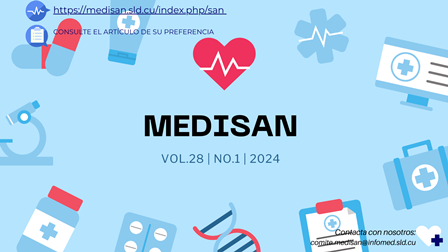Construct validation of a hypnotherapeutic algorithm for children with monosymptomatic bedwetting
Keywords:
child, hypnosis, bedwetting, construct validation, factorial analysis, main component analysis.Abstract
Introduction: Bedwetting is a frequent reason to visit pediatric, infant psychiatry, psychology and family medicine services, with more percentage in 5 years children, followed by 7 and 9 years children, in that order.
Objective: To determine the construct validity of the hypnotherapeutic algorithm for patients with monosymptomatic bedwetting.
Methods: A complex investigation of 97 patients was carried out, who were assisted in the Therapeutic Hypnosis Clinic of the University of Medical Sciences in Santiago de Cuba, from February, 2021, to July, 2022 which was structured in 3 methodological phases of construct validation to continue the phase IV of hypnotherapeutic algorithm content validation, on the base of 2 quasi-experiments without control group and a quasi-experiment with non equivalent control group of the second phase of this investigation.
Results: The factorial analysis on the study of main components was possible, because the factors 1, 2 and 3 should stay, which was expressed in the sedimentation graph and in the explained total variance, through the percentages accumulated in the initial auto values and the sum of saturations to the square of extraction and rotation with 64.24%.
Conclusions: The construct validation of the designed algorithm showed relevancy, given by the suitability of the factorial analysis and the Bartlett test of spherical form.
Downloads
References
2. Klriegman RM, Geme JW, Nathan J, Blum Samir S. Enuresis y disfunción miccional. En: Nelson. Tratado de Pediatría. T 2. 21 ed. Madrid: Elsevier; 2020.
3. American Psychiatric Association. Guía de consulta de los criterios diagnósticos del DSM-5TM. 5 ed. Arlington, VA: APA; 2013 [citado 27/04/2022]. Disponible en: https://www.eafit.edu.co/ninos/reddelaspreguntas/Documents/dsm-v-guia-consulta-manual-diagnostico-estadistico-trastornos-mentales.pdf
4. Hernández García S, Rodríguez Arencibia MÁ, Sosa Fernández A, Luis Rivero A, Mireles Hernández OM. Enuresis no orgánica tratada con medicamentos homeopáticos. Rev. cienc. méd. Pinar Río. 2020 [citado 04/06/2022];24(4). Disponible en: https://revcmpinar.sld.cu/index.php/publicaciones/article/view/4265/4324
5. Bani-Hani M, Alhouri A, Sharabi A, Saleh S, Nawafleh S, Al-zubi M, et al. New insights in treatment of monosymptomatic enuresis. Ann Med Surg (Lond). 2021 [citado 27/04/2022];67:102470. Disponible en: https://www.ncbi.nlm.nih.gov/pmc/articles/PMC8196056/
6. Asociación Española de Pediatría. Enuresis. 2008 [citado 07/04/2022]. Disponible en: https://www.aeped.es/sites/default/files/documentos/enuresis.pdf
7. Moretti EC. Comparação da eficácia e custo-utilidade entre diferentes opções de tratamento da enurese em crianças e adolescentes sob a perspectiva do Sistema Único de Saúde brasileiro. [Tesis]. Recife: Universidade Federal de Pernambuco; 2022 [citado 08/10/2022]. Disponible en: https://attena.ufpe.br/bitstream/123456789/45700/1/TESE%20Eduarda%20Correia%20Moretti.pdf
8. Lambert Delgado A, Cobián Mena AE, Fuentes Domínguez N, Sánchez Hechavarría ME. Efectividad del tratamiento hipnoterapeútico en la enuresis primaria monosintomatica. TEPS. 2022 [citado 2022 Apr 30];39(3):[aprox.10 p.]. Disponible en: http://teps.cl/index.php/teps/article/view/427
9. Lambert Delgado AR, Cobián Mena AE. Validación de un algoritmo hipnoterapéutico para niños con enuresis nocturna monosintomatica. Medisan (Santiago de Cuba). 2022 [citado 07/07/2023];26(6). Disponible en: https://medisan.sld.cu/index.php/san/article/view/4360/html
10. Hernández R, Fernández C, Baptista P, Méndez S, Paulina C. Metodologı́a de la investigación. 6 ed. México, D.F.: Mcgraw-Hill Education; 2014.
11. Oyola García AE, Zagaceta Guevara Z, Quispe Ilanzo MP. Validación del constructo y confiabilidad del Maslach Burnout Inventory-Human Services Survey (MBI-HSS) en médicos peruanos. Rev. hosp. psiq. hab. 2023 [citado 13/09/2023];20(2). Disponible en: https://revhph.sld.cu/index.php/hph/article/view/339/192
12. Calvo D. Clúster Jerárquicos y no jerárquicos. 2018 [citado 06/06/2022]. Disponible en: https://www.diegocalvo.es/cluster-jerarquicos-y-no-jerarquicos/
13. Chiner E. La validez. 2003 [citado 03/06/2022]. Disponible en: https://rua.ua.es/dspace/bitstream/10045/19380/25/Tema%206-Validez.pdf
14. Castañeda E, Krikorian A. Aplicaciones actuales de la hipnosis clínica en Latinoamérica: una revisión sistemática de la literatura. Avances en Psicología Latinoamericana. 2018 [citado 15/05/2021];36(2). Disponible en: https://revistas.urosario.edu.co/xml/799/79955443004/html/index.html
15. Reyes Valenzuela R, Marrón Ramos DN, González Torres A, Juárez Rodríguez R, Mendoza Montero FY. Análisis de validez de contenido por criterio de jueces de un instrumento para evaluar un manuscrito. RIDE. 2022 [citado 27/04/2022];12(24). Disponible en: https://www.scielo.org.mx/scielo.php?script=sci_arttext&pid=S2007-74672022000100037
16. Silva MMJ, Dos Santos CB, Clapis MJ. Construct elaboration and validity of the Pregnancy Depression Risk Scale. Rev Bras Enferm. 2023 [citado 20/09/2023];76(2):e20220306. Disponible en: https://www.ncbi.nlm.nih.gov/pmc/articles/PMC9987458/
17. Magaña Medina DE, Hernández Mena V, Aguilar Morales N, Sánchez Escobedo PA. Apoyo de pares y expectativas de resultado en STEM: desarrollo y validación de un instrumento. REDIE. 2023 [citado 13/09/2023];25. Disponible en: https://redie.uabc.mx/redie/article/view/4274/2367
Published
How to Cite
Issue
Section
License
All the articles can be downloaded or read for free. The journal does not charge any amount of money to the authors for the reception, edition or the publication of the articles, making the whole process completely free. Medisan has no embargo period and it is published under the license of Creative Commons, International Non Commercial Recognition 4.0, which authorizes the copy, reproduction and the total or partial distribution of the articles in any format or platform, with the conditions of citing the source of information and not to be used for profitable purposes.





